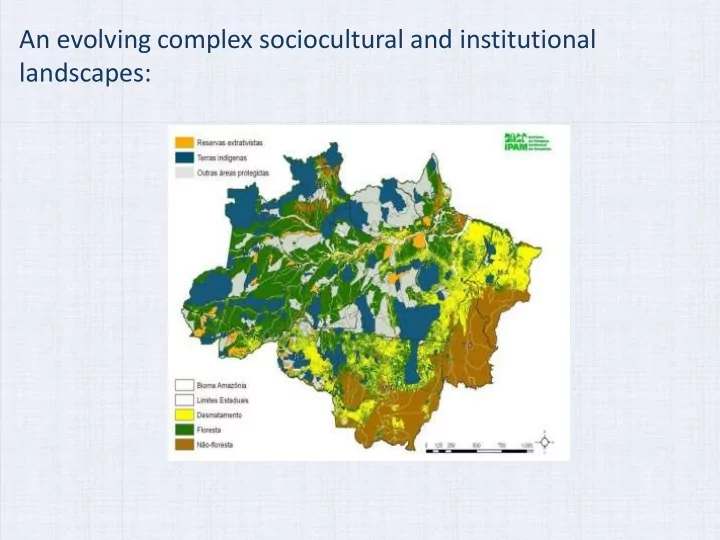

An evolving complex sociocultural and institutional landscapes:
Functional Inter-dependence: Social, physical, institutional connectivity within watersheds Deforestation (red) by Deforestation (red) by 1994 2005 Source: Instituto Socioambiental [ISA 2007] http://www.yikatuxingu.org.br/revista/revista-ingles.pdf The Xingu Indigenous Park within the larger watershed Brondizio, E. S., E. Ostrom, O. Young. (2009) Connectivity and the governance of socioecological systems: the role of social capital. Annual Review of Environment and Resources.Vol 34: 255
Governance challenges created by cross-level interactions a. Fit : level of (mis)matches between environmental and institutional boundaries; b. Boundaries : competing rules of subtractability and exclusion operating in different parts of the same ecosystem; c. Authority : shifts in jurisdiction and authority over resources, including overlaps, at different levels; d. Sanctions : inverted correlation between compliance with rules and scale (i.e., level of compliance decreases as you move from local to international levels); e. Knowledge and information : problems of credibility, saliency, and legitimacy resulting from differences in knowledge systems and access to information at different levels and by different groups. Brondizio, E. S., E. Ostrom, O. Young. (2009) Connectivity and the governance of socioecological systems: the role of social capital. Annual Review of Environment and Resources.Vol 34: 255
Untangling factors underlying trajectories of deforestation and LUCC change as level-dependent
<1972 <1979 <1986 <1991 <2001
Multi-Level Deforestation Trajectories 1972-2001 100 ( a) Regional Brazilian Amazon, State of Para 75 the Amazon, 1970-2001, Population and Environment. From: Brondizio, E. and E. Moran (under review) Level- dependent deforestation trajectories in 50 25 0 2 9 1 1 6 100 on tate (b) Sub-regions Research sub-regions (n=3) ns nia s 75 50 25 0 100 Cohort groups, Transamazon (n=8) 75 and Communities (c) Farm cohorts 50 25 0 100 Communities Amazon estuary sub-region (n=6) 75 50 25 Farm-level (>9,000) (d) Farm Lots 0 Def <1972 Def <1979 Def <1986 Def <1991 Def <2001
3. Implications for sustainability • Not complexity for the sake of complexity: It matters to policy – Functional inter-dependence and linkages between levels and different institutional arrangements and economic systems – Evolving rural-urban network systems defining future regional landscapes • From ‘panacea’ to ‘ mesoscopic ’ approaches to policy – Account for intra-regional variability and underlying persisting structural problems – Limitations of level specific policy approaches ‘ Policentrism ’ – Link regional models of climate change to local level needs • Towards a transformative economy – Limitations of compensation mechanisms to deal with regional complexity – Aggregating resource value and generating employment at the local and regional levels – Overcome disconnection of municipalities from regional resource economy – Locally developed solutions for environment management and agropastoral intensification
THANK YOU!
Rural community formation, Santarem region 2003 Number of Families Rural Population ~180,000 to 200,000
Growing pressure on urban infrastructure, employment Vicious cycle : -Increase urban population and demand for services -Lack of ability to provide urban infrastructure and public goods -Persistent unemployment Costa, S. M. and E. S. Brondizio. 2009 Inter-Urban Dependency among Amazonian Cities: Urban Growth, Infrastructure Deficiencies, and Socio-Demographic Networks. REDES (Brazil) 14(3): 211 – 234
Concentration of Wealth in the Amazon estuary Inequality in Income Distribution (L de Theil index) IPEA data Ponta de Pedras 1970-2000 Forest-based economy L de Theil Inequality Index 0.6 Lack of transformative 0.5 0.4 industries 0.3 0.2 Value added away from 0.1 the region 0 1970 1980 1991 2000 Competitive disadvantage for producers - Municipalities disconnected from resource economies Brondizio, E. S. 2010 In M. Pinedo-Vasquez, M. Ruffino, E. S. Brondizio, C. Padoch,.(eds) The Amazonian Varzea/ . Springer/ Brondizio, E. S. 2010.In K. Morrison, S. Hetch, and C. Padoch (eds). The Social Life of Forests. The U. Chicago Press
Small Farmers, Food Production, and Security IBGE Agropastoral Census 2006 • Properties <10ha=2.4% area 75% of rural employment • Properties >1000ha=44% area • Properties > 2000ha > 80% deforested area • Small farmers: 24% agropastoral area (% national prod): • -87% Manioc -38% Coffee -21% Wheat • -70% Beans -34% Rice -16% Soybean • -46% Corn -58% Milk
Limitations of Ecosystem Services Valuation -Contrasting cultural perspectives to nature -Long-term implications of commodifying nature as property -Resource value aggregated outside the region -Local efforts undermined by regional changes
Recommend
More recommend